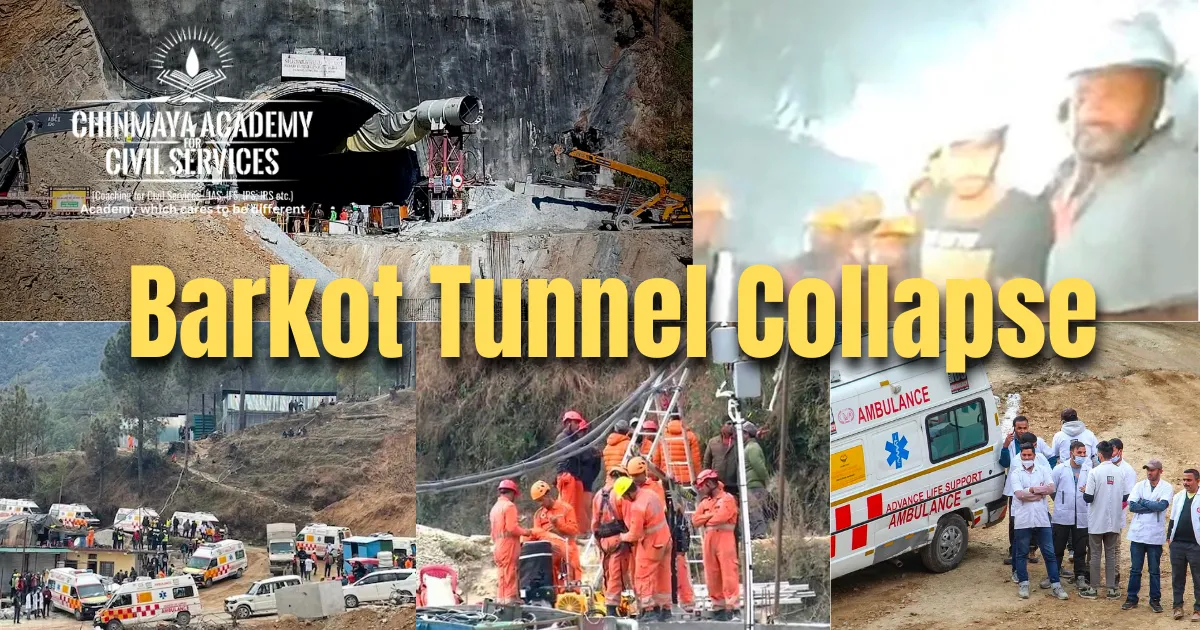
The Silkyara tunnel collapse occurred on November 12, 2023, when a portion of the under-construction Silkyara Bend – Barkot tunnel collapsed in the Uttarkashi district of Uttarakhand, India.
Incident
- On November 12, 2023, a portion of the under-construction Silkyara Bend – Barkot tunnel collapsed in the Uttarkashi district of Uttarakhand, India.
- The collapse occurred at around 05:30 AM IST and trapped 41 workers inside the tunnel.
- Rescue operations were immediately launched, and all 41 workers were rescued by the evening of November 13, 2023.
- An inquiry has been ordered into the cause of the collapse.
Potential Reasons
While the exact cause of the collapse is still under investigation, experts have identified several possible factors that may have contributed to the incident.
Geological Factors
- Geological Instability: The region where the tunnel is being constructed is known for its geological instability, with a history of landslides and earthquakes. The presence of weak or fractured rock formations, shear zones, and water-filled fissures can increase the risk of tunnel collapses.
- Water Seepage: Uncontrolled water seepage into the tunnel could have weakened the surrounding rock formations, leading to erosion and structural instability. Heavy rainfall in the area before the collapse may have exacerbated this issue.
Construction Factors
- Design and Excavation Methods: The design of the tunnel and the excavation methods employed may have played a role in the collapse. Improper tunnel design or the use of inappropriate excavation techniques could have led to stress concentrations and instability in the rock structure.
- Construction Materials and Quality Control: The quality of construction materials and the effectiveness of quality control measures can significantly impact tunnel safety. Substandard materials or inadequate supervision could have resulted in weakened structures or undetected flaws.
- Monitoring and Safety Protocols: The implementation of proper monitoring and safety protocols is crucial for identifying potential hazards and preventing tunnel collapses. Insufficient monitoring systems or a lax approach to safety procedures could have contributed to the incident.
Environmental Factors
- Weather Conditions: Heavy rainfall and snowfall can increase the risk of tunnel collapses by saturating the surrounding soil and rocks, reducing their stability. The timing of the collapse, coinciding with heavy rainfall, suggests that weather conditions may have played a role.
- Vegetation Cover: Vegetation removal during tunnel construction can alter the natural drainage patterns and destabilize slopes, increasing the risk of landslides. Proper vegetation management practices could have mitigated this risk.
Investigations and Prevention
A thorough investigation is ongoing to determine the definitive cause of the Silkyara tunnel collapse. The findings of the investigation will be crucial for improving safety measures and preventing similar incidents in the future.
To enhance tunnel safety
- Thorough Geological Assessments: Conducting comprehensive geological studies to identify and address potential hazards before construction begins.
- Rigorous Design and Construction Standards: Enforcing strict design standards and construction practices that adhere to established safety guidelines.
- Effective Monitoring and Safety Audits: Implementing robust monitoring systems and conducting regular safety audits to identify and rectify potential problems promptly.
- Environmental Considerations: Incorporating environmental considerations into tunnel design and construction to minimize the impact on surrounding ecosystems and mitigate weather-related risks.
By addressing these potential causes and implementing stricter safety measures, the risk of tunnel collapses can be significantly reduced, ensuring the safety of workers and the integrity of infrastructure projects.
Impact of the collapse
Immediate Impact
- Human Cost: The collapse trapped 41 workers inside the tunnel, and a massive rescue operation was launched. Fortunately, all 41 workers were rescued, but the incident highlighted the potential dangers of tunnel construction projects.
- Infrastructure Disruption: The collapse caused significant damage to the under-construction tunnel, halting construction and delaying the completion of the project. The tunnel is part of a larger project to improve connectivity between Uttarkashi and Yamunotri, and the collapse has set back the overall project timeline.
Long-term Impact
- Safety Concerns: The collapse raised concerns about the safety of other infrastructure projects in Uttarakhand, particularly those involving tunnel construction. The incident prompted calls for stricter safety regulations and enhanced monitoring of construction sites.
- Economic Impact: The collapse has had an economic impact on the region, as it has delayed the completion of the project and diverted resources towards rescue and recovery efforts. The disruption in connectivity could also have indirect economic consequences for local businesses and tourism.
- Environmental Concerns: The collapse has raised environmental concerns about the impact of infrastructure projects on the fragile Himalayan ecosystem. Environmental groups have called for a more sustainable approach to infrastructure development, considering the delicate balance of the region’s ecology.
The Silkyara tunnel collapse serves as a stark reminder of the importance of prioritizing safety in infrastructure projects. It underscores the need for thorough geological assessments, rigorous design standards, and effective monitoring systems to prevent similar incidents in the future.
The collapse also highlights the need for a more holistic approach to infrastructure development, considering not only the immediate economic benefits but also the long-term environmental and social impacts. Sustainable infrastructure development should prioritize the safety of workers, minimize environmental disruptions, and enhance the well-being of local communities.
Lessons learned from the collapse
- The collapse is a reminder of the importance of careful planning and execution of infrastructure projects.
- It is also important to carry out regular safety audits of infrastructure projects.
- The collapse has also highlighted the need for better disaster preparedness in Uttarakhand.
 Chinmaya IAS Academy – Current Affairs Chinmaya IAS Academy – Current Affairs
Chinmaya IAS Academy – Current Affairs Chinmaya IAS Academy – Current Affairs
